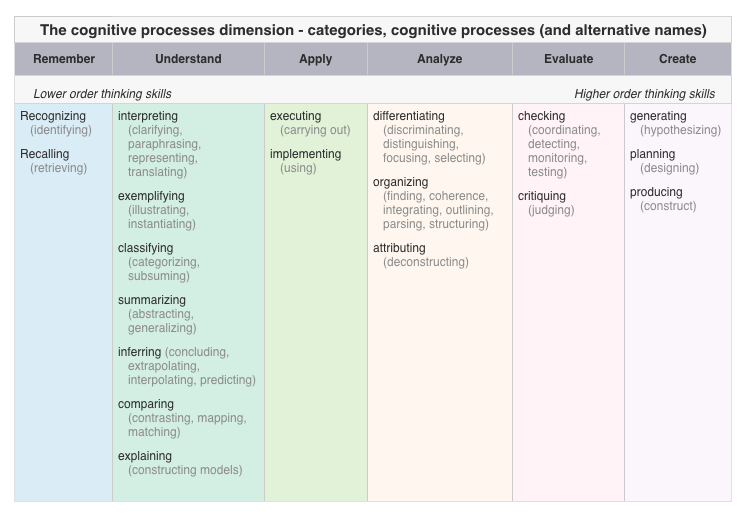Goals and objectives are the core of any course. They define the expectations, and guide the course materials and assessments. All course assessments (assignments and tests) should be support course goals and objectives.
What is a Goal?
Goals are the broad statements describing what the course intends to accomplish with the student learning. Goals do not include criteria for achievement, thus are not directly measurable and are supported by defining multiple objectives that provide examples of student performance that support the goal.
What is a Objectives?
Objectives briefly describe the type of performance that demonstrates the learning outcomes (Cognitive, Affective, or Behavioral). They have two primary purposes, to frame the assessment and describe the level of student learning. Reference Bloom’s Taxonomy Model listed below for example verbs that can be utilized for objectives. You can also find additional verbs with an Internert search for Bloom’s action verbs.
Outcomes
Outcomes are the examples that students produce to illustrate the achieved results of learning. Most often outcome statements are the objective restated in a result statement. Outcome statements are not always included in syllabi, but may be seen in assessment criteria and/or rubrics.
Example: Goals, Objectives, and Outcome statements
1. Students will develop critical thinking toward research (Goal)
1.1 A description from recent literature, not older than ten year, will be developed describing the current state of the research topic (Objective)
Student will utilize recent articles that are not older than ten years to describe the current state and considerations of the research topic (Outcome)
1.2 At least five articles will be included to support the student’s argument will be referenced and cited. (Objective)
Student included five articles supporting their rationale for their argument to address the research topic (Outcome)
1.3 Alternitive perspectives, minumum of two, will be included from the literature with supporting references (Objective)
Student describes in detail and contrasts at least two alliterative perspective that deviate from their argument. (Outcome)
Reference: Bloom’s Revised Taxonomy Model
Bloom’s Taxonomy can be used to help determine the level of cognitive complexity that is expected when developing objectives. The table below includes some verb that can be utilized to represent that various cognitive dimensions from lower order thinking to higher order thinking.
- Remembering: Retrieving, recognizing, and recalling relevant knowledge from long-term memory.
- Understanding: Constructing meaning from oral, written, and graphic messages through interpreting, exemplifying, classifying, summarizing, inferring, comparing, and explaining.
- Applying: Carrying out or using a procedure through executing, or implementing.
- Analyzing: Breaking material into constituent parts, determining how the parts relate to one another and to an overall structure or purpose through differentiating, organizing, and attributing.
- Evaluating: Making judgments based on criteria and standards through checking and critiquing.
- Creating: Putting elements together to form a coherent or functional whole; reorganizing elements into a new pattern or structure through generating, planning, or producing.

References
Anderson, L.W., & Krathwohl (Eds.). (2001). A Taxonomy for Learning, Teaching, and Assessing: A Revision of Bloom’s Taxonomy of Educational Objectives. New York: Longman.
Bloom, B.S. and Krathwohl, D. R. (1956). Taxonomy of Educational Objectives: The Classification of Educational Goals, by a committee of college and university examiners. Handbook I: Cognitive Domain. NY, NY: Longmans, Green.
Oliva, P. F. (2009). Developing the Curriculum (7 ed.). Pearson Education, Inc.
Woolfolk, A. (2012). Educational Psychology (12 ed.). Boston, MA: Person. http://doi.org/10.1037/h0071291
